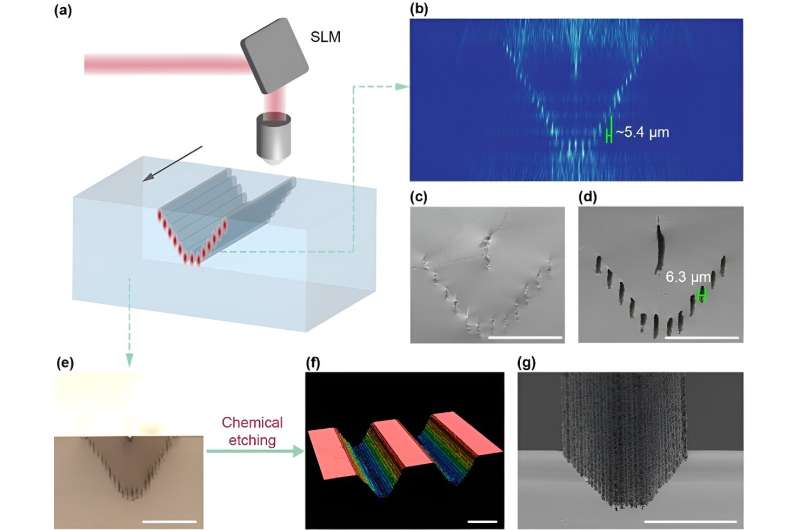
October 11, 2024 by Compuscript Ltd
Collected at: https://phys.org/news/2024-10-dimensional-multi-focus-laser-glass.html
Glass materials are widely used in optical and optoelectronic devices due to their low cost and excellent mechanical and optical properties. Among them, glass concave/convex linear structures with feature sizes ranging from several micrometers to hundreds of micrometers find intensive applications.
For instance, cylindrical microlens arrays and microgroove arrays with various cross-sections are widely used for light field modulation, microfluidic chip flow channels, and optical module connectors. The inherent hardness, brittleness and low thermal conductivity of glass make it highly challenging to fabricate large-area glass microgrooves, especially those with tunable cross-sectional shapes.
As a non-contact subtractive manufacturing method, ultrafast laser processing plays an important role in the fabrication of glass microstructures. The extremely high peak power density and short pulse duration time help to achieve small thermal impact, few defects and high precision.
However, relying solely on single-spot laser direct writing, the processing efficiency and the obtained surface quality are quite difficult to meet the real application requirements. Previous research has proven that the laser processing flexibility can be largely improved if beam shaping can be combined.
There is an opportunity to achieve efficient and high-quality engraving of glass microstructures with arbitrary cross-sectional shapes on the glass surface by laser processing with beam shaping. The related research is both academically and industrially valuable.
The research team of Prof. Xu from Southern University of Science and Technology has introduced a novel laser-based micromachining approach: the utilization of high-precision multi-focus laser to efficiently fabricate high-precision customizable glass grooves with a scale from tens to hundreds of micrometers. The research is published in the journal Opto-Electronic Advances.
This methodology effectively addresses the challenges of cross-sectional profile controllability and accuracy associated with glass groove fabrication. Specifically, the modulating algorithm developed as part of this approach corrects position deviations of multi-focus laser stemming from the glass’s refractive index and nonparaxial conditions. Additionally, it ameliorates the degradation in multi-focus energy uniformity caused by circular Moiré patterns on the phase diagram. This is achieved through a combination of coordinate randomization and energy adjustment strategies.
 Diverse sectional profiles of glass grooves achieved through spatial multi-focus laser processing combined with chemical etching, along with their various applications. (a) Symmetric and asymmetric V-shaped grooves on fused silica. (b) Arc-shaped grooves on fused silica. (c) Cylinder arrays formed by continuous grooves on fused silica. (d) Trapezoid grooves on borosilicate glass used for optical fiber packaging. Scale bars: 100 μm. Credit: Opto-Electronic Advances (2024). DOI: 10.29026/oea.2025.240082
Diverse sectional profiles of glass grooves achieved through spatial multi-focus laser processing combined with chemical etching, along with their various applications. (a) Symmetric and asymmetric V-shaped grooves on fused silica. (b) Arc-shaped grooves on fused silica. (c) Cylinder arrays formed by continuous grooves on fused silica. (d) Trapezoid grooves on borosilicate glass used for optical fiber packaging. Scale bars: 100 μm. Credit: Opto-Electronic Advances (2024). DOI: 10.29026/oea.2025.240082 Uniformity improving of multi focus by randomization of their coordinates in fused silica. Illustration, phase diagram fast Fourier transform images of phase diagrams showing circular Moiré patterns, light intensity field simulation, and bulk ablation of V-shape dot array with uniform multi foci of 13 points (a), 21 points (b), and 21 points with randomized position (c). Scale bars: 100 μm. Credit: Opto-Electronic Advances (2024). DOI: 10.29026/oea.2025.240082
Uniformity improving of multi focus by randomization of their coordinates in fused silica. Illustration, phase diagram fast Fourier transform images of phase diagrams showing circular Moiré patterns, light intensity field simulation, and bulk ablation of V-shape dot array with uniform multi foci of 13 points (a), 21 points (b), and 21 points with randomized position (c). Scale bars: 100 μm. Credit: Opto-Electronic Advances (2024). DOI: 10.29026/oea.2025.240082
The outcome of the methodology is a precise multi-focus laser that seamlessly aligns with the designed groove profile. This alignment significantly expedites the production of glass grooves, a process further enhanced by subsequent chemical etching.
The developed technique accommodates a wide range of groove geometries, including trapezoidal, high-aspect-ratio triangle, and semicircle grooves. Furthermore, the researchers have explored practical applications of these glass grooves, such as trapezoidal groove arrays ideal for optical fiber packaging.
The significance of the research lies in its elucidation of the untapped potential and versatility inherent in laser structured glass for advanced applications. The work not only contributes to the advancement of optical and optoelectronic technologies but also paves the way for innovations in various industries reliant on structured glass-based systems.
More information: Kang Xu et al, High-precision multi-focus laser sculpting of microstructured glass, Opto-Electronic Advances (2024). DOI: 10.29026/oea.2025.240082

Leave a Reply